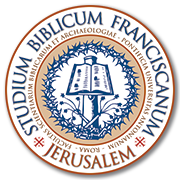Historical Archaeology of the Gospel Scenes in the Holy Land
Prof. Győző Vörös
II semestre
As a result of extensive archaeological research during the last decades, the accurate understanding of the Holy Land, during the time of the ministry of Jesus, seriously developed. The Seminar is giving an overview of the divided Roman-Herodian Holy Land in ca. 30 AD, with the contemporary roads and settlements in its changing historical landscape, together with their built legacy and the material-culture of the Romanized and mixed cultural anthropological surrounding. It will also discuss the different types of imaginative Holy Dreamlands, that became a sweet spiritual home for different kind of religions and peoples, but which never existed in history. The Seminar will have eight integral parts during the four weeks of the lecture-series. Each lecture will be 90 minutes.
First week:
1./ Religious landscapes and the imaginative Holy Lands.
2./ The historical places that can be visited today.
Second week:
3./ The historical landscapes, which have been disappeared.
4./ The unknown, the probable and the unidentified Gospel scenes.
Third week:
5./ The holy city of Jerusalem in the time of Jesus.
6./ The changing maps of the Holy Land pilgrims in history.
Fourth week:
7./ Free academic consultations and questions, concerning the Seminar.
8./ Conclusion: The Limits and Future of Gospel Archaeology.
The active participation on the Archaeological Seminar will result 1 credit, meanwhile with a possible paper there is an opportunity for an additional second credit, which have to be written (in English or in Italian) on one of the archaeological sites in the Holy Land (mentioned in the Gospels) in around 30 AD, or on one of the archaeological object-groups in the Early Roman material-culture of ancient Palestine (i.e.: opus sectile, opus tesselatum, gypsum mouldings, coins etc.).
• E. Netzer, The Architecture of Herod the Great Builder, Tübingen 2009
• D.T. Ariel – J-Ph. Fontanille, The Coins of Herod, Leiden 2012
• A. Spijkerman, The Coins of the Decapolis and Provincia Arabia. Edited with historical and geographical introductions by M. Piccirillo, Jerusalem 1978 [SBF Collectio Maior No. 25]
• S. Rozenberg – D. Mevorach (eds.), Herod the Great – The King’s Final Journey, Jerusalem 2013
• E. Netzer – Gy. Vörös et alii, Herod’s Palace-Fortresses, Washington 2015
• R. Porat et alii, Herodium. Final Reports of the 1972–2010 Excavations, Vol. I, Jerusalem 2015
The Collectio Maior archaeological-excavation final-report academic-monographs [with their series numbers] of the Studium Biblicum Franciscanum, on the archaeological sites, connected to the topic of the Seminar (in order, as they are related to the chronology of the Gospel narratives):
BETLEHEM:
• B. Bagatti, Gli antichi edifici sacri di Betlemme. In seguito agli scavi e restauri praticati dalla Custodia di Terra Santa (1948-51), Jerusalem 1952 / reprinted 1983 [No. 9]
HERODION:
• V.C. Corbo, Herodion. I: Gli edifici della reggia-fortezza, Jerusalem 1989 [No. 20a]
• A. Spijkerman, Herodion. III: Catalogo delle monete, Jerusalem 1972 [No. 20b]
• E. Testa, Herodion. IV: I graffiti e gli ostraka, Jerusalem 1972 [No. 20c]
• S. Loffreda, La ceramica di Macheronte e dell’Herodion (90 a.C. - 135 d.C.), Jerusalem 1996 [No. 39. Originally planned as Herodion II, but also consists the ceramological material of Machaerus]
NAZARETH
• B. Bagatti, Gli scavi di Nazaret. I: Dalle origini al secolo XII, Jerusalem 1967 | trans. English: Excavations in Nazareth. I: From the Beginning till the XII Century. Translated by E. Hoade, Jerusalem 1969 [No. 17a]
CAPERNAUM:
• V.C. Corbo, Cafarnao. I: Gli edifici della città, Jerusalem 1975 [No. 19a]
• S. Loffreda, Cafarnao. II: La ceramica, Jerusalem 1974 [No. 19b]
• A. Spijkerman, Cafarnao. III: Catalogo delle monete della città, Jerusalem 1975 [No. 19c]
• E. Testa, Cafarnao. IV: I graffiti della Casa di S. Pietro, Jerusalem 1972 [No. 19d]
• S. Loffreda, Cafarnao. V: Documentazione fotografica degli scavi (1968-2003), Jerusalem 2003 [No. 44]
• S. Loffreda, Cafarnao. VI: Tipologie e contesti stratigrafici della ceramica (1968-2003), Jerusalem 2008 [No. 48]
• S. Loffreda, Cafarnao. VII: Documentazione grafica della ceramica (1968-2003), Jerusalem 2008 [No. 49]
• S. Loffreda, Cafarnao. VIII: Documentazione fotografica degli oggetti (1968-2003), Jerusalem 2008 [No. 50]
• B. Callegher, Cafarnao. IX: Monete dall’area urbana di Cafarnao (1968-2003), Jerusalem 2007 [No. 47]
MACHAERUS:
• Gy. Vörös, Machaerus I: History, Archaeology and Architecture of the Fortified Herodian Royal Palace and City Overlooking the Dead Sea in Transjordan. Final Report of the Excavations and Surveys 1807–2012, Milan 2013 [No. 53]
• Gy. Vörös, Machaerus II: The Hungarian Archaeological Mission in the Light of the American-Baptist and Italian-Franciscan Excavations and Surveys. Final Report 1968–2015, Milan 2015 [No. 55]
• Gy. Vörös et al., Machaerus III: The Golden Jubilee of the Archaeological Excavations. Final Report on the Herodian Citadel 1968–2018, Jerusalem - Milan - Mount Nebo 2019 [No. 56]
MOUNT OF OLIVES:
• S.J. Saller, Excavations at Bethany (1949-1953), Jerusalem 1957 / reprinted 1982 [No. 12]
• B. Bagatti - J.T. Milik, Gli scavi del “Dominus Flevit” (Monte Oliveto – Gerusalemme). Parte I: La necropoli del Periodo Romano, Jerusalem 1958 / reprinted 1981 [No. 13a]
• S.J. Saller, The Excavations at Dominus Flevit (Mount Olivet, Jerusalem). Part II: The Jebusite Burial Place, Jerusalem 1964 [13b]
• V.C. Corbo, Ricerche archeologiche al Monte degli Ulivi, Jerusalem 1965 / reprinted 2004 [No. 16]


